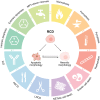Molecular mechanisms of cell death: recommendations of the Nomenclature Committee on Cell Death 2018
- PMID: 29362479
- PMCID: PMC5864239
- DOI: 10.1038/s41418-017-0012-4
Molecular mechanisms of cell death: recommendations of the Nomenclature Committee on Cell Death 2018
Abstract
Over the past decade, the Nomenclature Committee on Cell Death (NCCD) has formulated guidelines for the definition and interpretation of cell death from morphological, biochemical, and functional perspectives. Since the field continues to expand and novel mechanisms that orchestrate multiple cell death pathways are unveiled, we propose an updated classification of cell death subroutines focusing on mechanistic and essential (as opposed to correlative and dispensable) aspects of the process. As we provide molecularly oriented definitions of terms including intrinsic apoptosis, extrinsic apoptosis, mitochondrial permeability transition (MPT)-driven necrosis, necroptosis, ferroptosis, pyroptosis, parthanatos, entotic cell death, NETotic cell death, lysosome-dependent cell death, autophagy-dependent cell death, immunogenic cell death, cellular senescence, and mitotic catastrophe, we discuss the utility of neologisms that refer to highly specialized instances of these processes. The mission of the NCCD is to provide a widely accepted nomenclature on cell death in support of the continued development of the field.
Conflict of interest statement
The authors declare that they have no competing financial interests.
Figures



References
Publication types
MeSH terms
Substances
Grants and funding
- R01 GM122923/GM/NIGMS NIH HHS/United States
- MC_UP_A600_1109/MRC_/Medical Research Council/United Kingdom
- R01 GM057587/GM/NIGMS NIH HHS/United States
- 20145/CRUK_/Cancer Research UK/United Kingdom
- P01 AG049665/AG/NIA NIH HHS/United States
- R01 GM053396/GM/NIGMS NIH HHS/United States
- R01 CA169291/CA/NCI NIH HHS/United States
- R01 HL142271/HL/NHLBI NIH HHS/United States
- MC_UU_00025/4/MRC_/Medical Research Council/United Kingdom
- MC_PC_12007/MRC_/Medical Research Council/United Kingdom
- R01 CA206005/CA/NCI NIH HHS/United States
- R01 CA076584/CA/NCI NIH HHS/United States
- R01 AI044828/AI/NIAID NIH HHS/United States
- MC_UU_00001/7/MRC_/Medical Research Council/United Kingdom
- R01 HL136954/HL/NHLBI NIH HHS/United States
- 22903/CRUK_/Cancer Research UK/United Kingdom
- R35 CA209896/CA/NCI NIH HHS/United States
- R35 GM131919/GM/NIGMS NIH HHS/United States
- R01 GM096208/GM/NIGMS NIH HHS/United States
- 15816/CRUK_/Cancer Research UK/United Kingdom
- R01 AG056259/AG/NIA NIH HHS/United States
- MC_U132670600/MRC_/Medical Research Council/United Kingdom
- R01 CA178394/CA/NCI NIH HHS/United States
- RF1 AG057409/AG/NIA NIH HHS/United States
- P30 CA008748/CA/NCI NIH HHS/United States
- 18274/CRUK_/Cancer Research UK/United Kingdom
- DP1 DA041722/DA/NIDA NIH HHS/United States
- 18278/CRUK_/Cancer Research UK/United Kingdom
- MR/M019217/1/MRC_/Medical Research Council/United Kingdom
- P01 CA013106/CA/NCI NIH HHS/United States
- R01 HL123966/HL/NHLBI NIH HHS/United States
- R37 AI044828/AI/NIAID NIH HHS/United States
- R21 CA202200/CA/NCI NIH HHS/United States
- MC_U132685863/MRC_/Medical Research Council/United Kingdom
LinkOut - more resources
Full Text Sources
Other Literature Sources
Research Materials
Miscellaneous

